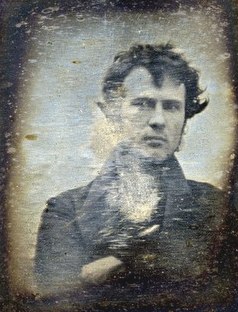My Dad gave me a bird feeder a few weeks ago, cause he's nice like that. I've never had a bird feeder before, never really thought that much about birds to begin with,...
Eminent Georgian Whackos
Ripped from the actual biography of a highly prominent 19th century American figure. Yes, one you have definitely heard of.
Born in Haiti in 1785 to a sea captain and his mistress, he grew up in revolutionary France and came to America to avoid Napoleon's draft. By way of Philadelphia and Kentucky, [he] settled in Louisiana in 1821...
Seriously? Why doesn't my biography start off like that?
I'm guessing that if that paragraph were printed on the back of a book -- possibly one with a lurid cover -- I would very likely want to buy that book. And then I would read the crap out of it.
But rather than forming the basis of a story about true love and high adventure, or some fol-de-rol like that, this adorable little paragraph forms the basis for the life of one of the 19th century's most well-known and respected men.
Let's see if you can guess with a little more information:
There he gave lessons to plantation belles and spent long days shooting birds and then painting them. He propped up dead birds with wires and meticulously recorded their colouring and conformation. He was self taught as an artist and naturalist.
That's right. If you were the son of a sea captain's mistress, a child of the French Revolution, and a draft-dodging refugee of the Napoleonic wars, you might decide that the only logical thing to do with your life would be to discover a passion for taxidermy, art, and the natural world, and then make a solemn vow to chronicle and catalogue every single species of bird on the entire continent of North America.
You might, in short, be a little bit nuts.
Ladies and gentlefolk, I give you John James Audubon.
He's got that slightly crazed, I'm-hounded-by-my-past look in his eye, don't you think?
His life didn't settle down as soon as he reached American shores, either. Turns out, he contracted yellow fever as soon as he arrived in New York, and to aid his recovery, his ship's captain dumped him rather unceremoniously in the hands of some Quaker friends who ran a charitable boarding house.
This is where Audubon first learned English, complete with the Quaker's fondness for the formal (and by then anachronistic) thee and thou. Which probably made a great deal of sense to a native French-speaker, with their formal niceties around vous and tu.
Then he made his way to the family homestead near Valley Forge, where he started tramping all over the hills and valleys of the paradisiacal landscape surrounding him, frequently accompanied by the neighbor's comely daughter, Lucy.
On one of these little jaunts, he had a serious fall. Which resulted in a serious fever, which naturally resulted in Lucy nursing him tenderly back to health.
He and Lucy married, of course.
I told you this could be one of those books.
But it doesn't stop there. He needed to get his father's permission to marry, so he went back to France -- where he was a draft-dodger, remember? And therefore vulnerable to harsh conscription or worse if found and arrested -- in 1805. While there, he picked up some advanced taxidermy tricks from a family friend.
You know. As one does.
Of course he went back to the States, married his Lucy, and set out on his mission to catalogue every single species of bird in America. He famously pioneered a more naturalistic way of depicting his specimens, and applied his not insignificant artistic skill in committing them to paper.
When Philadelphia and New York failed to yield an interested publisher, he set sail for England, where he immediately generated significant interest -- and funds -- among the more scientifically inclined members of the British aristocracy.
King George IV (the recently elevated Prince Regent) was a big fan, and eventually was responsible for getting Audubon elected to the Royal Society.
This made our sea captain's bastard son only the second American to be so honored, right after noted runaway and fugitive apprentice Benjamin Franklin.
Not bad, you old rascal. Not bad.
.png?width=500&height=500&name=bd%20(3).png)


